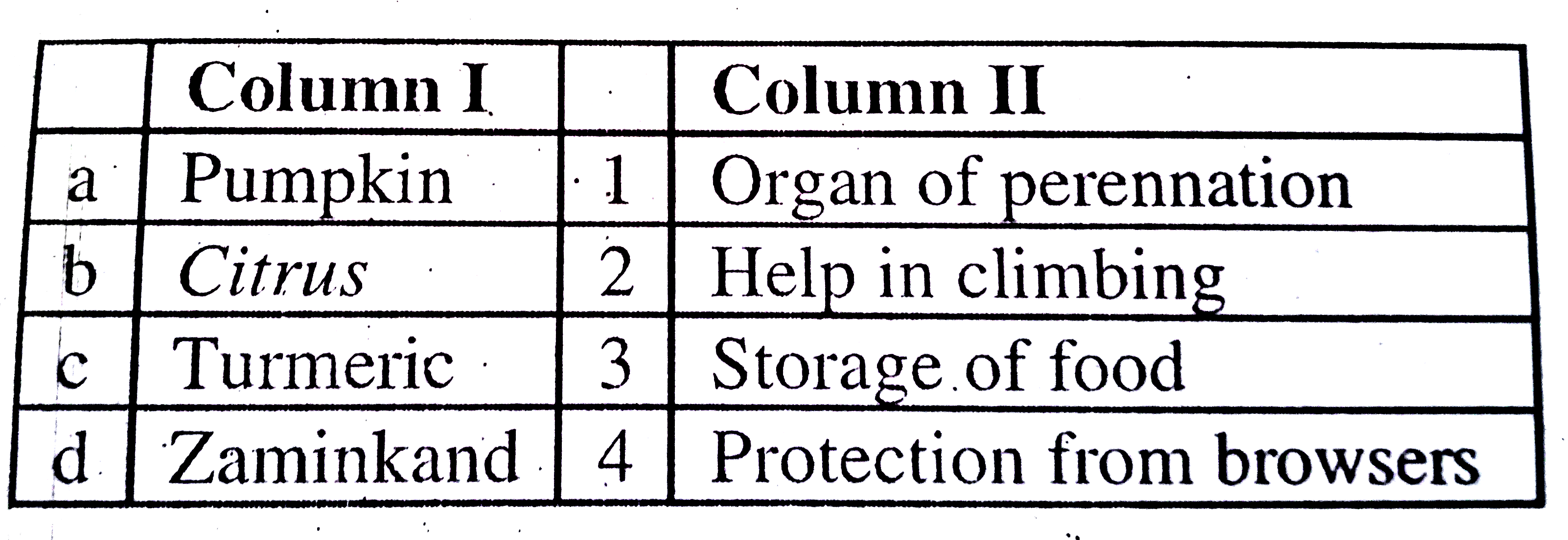MODIFICATIONS OF STEM
Step-by-Step Text Solution for "Modifications of Stem"
1. Introduction to Stem Modifications:
- The stem of a plant can undergo various modifications to perform functions beyond its typical roles of supporting the plant and conducting nutrients. These modifications are adaptations that help the plant survive in its environment.
2. Types of Stem Modifications:
- Tuber:
- A common example of a stem modification for food storage is the potato. The potato is an underground stem that swells to form a tuber, which stores reserve food materials. It also serves as an organ of perennation, allowing the plant to survive unfavorable conditions, and can facilitate vegetative propagation through its "eyes" (nodes).
- Tendrils:
- In some plants, the axillary buds of the stem are modified into slender, thread-like structures known as tendrils. These tendrils provide support to climbing plants, such as grapevines and cucurbits (e.g., watermelon, cucumber), allowing them to grow upward by coiling around supports.
- Thorns:
- The axillary buds can also be modified into woody, pointed structures called thorns. Thorns serve as a protective mechanism for plants like citrus and bougainvillea, deterring herbivores from feeding on them.
- Photosynthetic Stems:
- In xerophytes (plants adapted to dry environments), stems can become green and fleshy, taking over the role of photosynthesis when leaves are reduced or absent. An example of this is the cactus (Opuntia), where the stem is flattened or cylindrical to maximize light absorption.
- Vegetative Propagation:
- Stems can also play a role in vegetative propagation. Some plants, like grasses, strawberries, and bananas, produce lateral branches that can grow into new plants, facilitating the spread of the species.
3. Summary of Functions:
- The main functions of stem modifications include:
- Food Storage: Tubers (e.g., potato).
- Support: Tendrils (e.g., grapevines).
- Protection: Thorns (e.g., citrus plants).
- Photosynthesis: Green stems (e.g., cacti).
- Vegetative Propagation: Lateral branches in various plants.
- The stem of a plant can undergo various modifications to perform functions beyond its typical roles of supporting the plant and conducting nutrients. These modifications are adaptations that help the plant survive in its environment.
- Tuber:
- A common example of a stem modification for food storage is the potato. The potato is an underground stem that swells to form a tuber, which stores reserve food materials. It also serves as an organ of perennation, allowing the plant to survive unfavorable conditions, and can facilitate vegetative propagation through its "eyes" (nodes).
- Tendrils:
- In some plants, the axillary buds of the stem are modified into slender, thread-like structures known as tendrils. These tendrils provide support to climbing plants, such as grapevines and cucurbits (e.g., watermelon, cucumber), allowing them to grow upward by coiling around supports.
- Thorns:
- The axillary buds can also be modified into woody, pointed structures called thorns. Thorns serve as a protective mechanism for plants like citrus and bougainvillea, deterring herbivores from feeding on them.
- Photosynthetic Stems:
- In xerophytes (plants adapted to dry environments), stems can become green and fleshy, taking over the role of photosynthesis when leaves are reduced or absent. An example of this is the cactus (Opuntia), where the stem is flattened or cylindrical to maximize light absorption.
- Vegetative Propagation:
- Stems can also play a role in vegetative propagation. Some plants, like grasses, strawberries, and bananas, produce lateral branches that can grow into new plants, facilitating the spread of the species.
- The main functions of stem modifications include:
- Food Storage: Tubers (e.g., potato).
- Support: Tendrils (e.g., grapevines).
- Protection: Thorns (e.g., citrus plants).
- Photosynthesis: Green stems (e.g., cacti).
- Vegetative Propagation: Lateral branches in various plants.
Topper's Solved these Questions
Similar Questions
Match the columns I and II, and choose the correct combination according to the modification of stem:-
 View Solution
View SolutionRoot modification seen in the stem of Maize and Sugarcane is
View SolutionWhich of the following statements is/are true
(A) It the stem is jointed with solid nodes and hollow internodes, it is called caudex
(B) In Tridax the stem is decumbent
(C) Corn is a condensed form of rhizome growing more or less in vertical direction
(D) Sucker is an underground modification of stem
(E) Biparous type of cymose branching is seem in Saraca.View SolutionIdentify the correct match between the types of stem modification and their examples.
Column IColumn IIi. Epigynya.Peachii.Perigynyb.China roseiii.Hypogynyc.CucumberView SolutionWhat is meant by modification of root? What type of modification of root is found in the
(a) Banyan tree
(b) Turnip
(c) Mangrove treesView SolutionWhat is meant by modification of root? What type of modification of root is found in the : (a) Banyan tree, (b) Turnip, (c) Mangrove trees?
View SolutionThe structure which contain vascular bundle and is modification of stem is
View SolutionModification of stem into leaf like cladodes is found in certain
View SolutionIn the given diagrams, A ( spine ) and B ( tendril ) are structured which are modifications of the stem. Then , probable examples of plants in which A and B can be observed , respectively , will be. :
 View Solution
View SolutionModification in the form of leaf spines and stem thorns is observed in
View Solution

